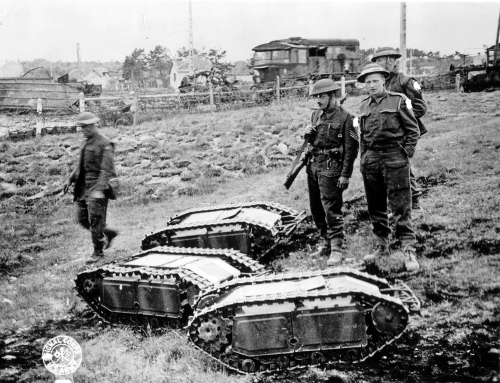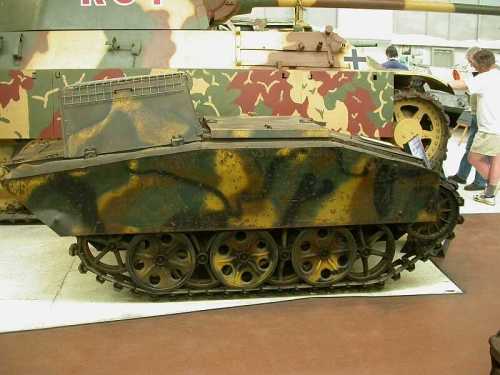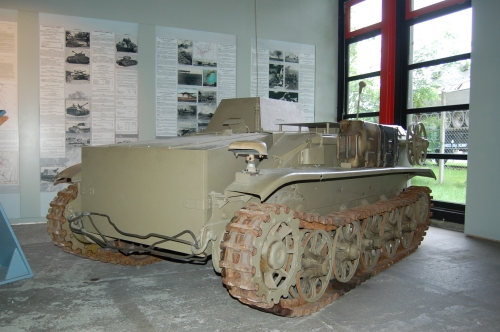During World War II, the German army (Wehrmacht) used three remotely operated Tracked mines: the light Goliath (Sd.Kfz. 302/303a/303b), the medium Springer (Sd.Kfz. 304) and the heavy Borgward IV (Sd.Kfz. 301).[7] Their task was to carry a charge of high explosives under armor protection into a target and detonate it there.
Demonstration of the Goliath tracked mine in the “Die Deutsche Wochenschau”
(German Weekly Newsreel, 1944). [13]
The electric drive was used for Goliath initially, but later it was changed to the gasoline engine. The Goliath was able to carry of 75-100 kg of explosives. The 7564 items of Goliath were produced totally.
The Springer was able to carry of 330 kg of explosives. A driver, who could sit in the back of the Springer, drove the vehicle close to the target. The final approach and the detonation of the charge was controlled by a wired or wireless remote control device.[5]
The Borgward IV [8] 1 was the largest of the mines and the only one capable of releasing its explosives before detonating (the two smaller vehicles were destroyed when their explosive charges detonated).
It should be noted that all tracked mines with remote control had the identical problems – they were expensive and they were not very reliable.
References:
1. Goliath tracked mine. – Mode of access: http://en.wikipedia.org/wiki/Goliath_tracked_mine .
2. British soldiers with captured German Goliath tracked mines. – Mode of access: http://en.wikipedia.org/wiki/File:Mini-tanks-p012953.jpg .
3. Голіаф (самохідна міна). – Mode of access: http://uk.wikipedia.org/wiki/%D0%93%D0%BE%D0%BB%D1%96%D0%B0%D1%84_%28%D1%81%D0%B0%D0%BC%D0%BE%D1%85%D1%96%D0%B4%D0%BD%D0%B0_%D0%BC%D1%96%D0%BD%D0%B0%29 .
4. Голиаф (самоходная мина). – Mode of access: http://ru.wikipedia.org/wiki/%D0%93%D0%BE%D0%BB%D0%B8%D0%B0%D1%84_%28%D1%81%D0%B0%D0%BC%D0%BE%D1%85%D0%BE%D0%B4%D0%BD%D0%B0%D1%8F_%D0%BC%D0%B8%D0%BD%D0%B0%29 .
5. Springer (tank). – Mode of access: http://en.wikipedia.org/wiki/Springer_%28tank%29 .
6. Springer Demolition Vehicle. – Mode of access: http://en.wikipedia.org/wiki/File:Springer_Demolition_Vehicle.jpg .
7. Borgward IV. – Mode of access: http://en.wikipedia.org/wiki/Borgward_IV .
8. The Office of the Chief of Ordnance, Washington D.C. // Catalog of Enemy Ordnance Material, Part 1, Page. – 1945. – Mode of access: http://en.wikipedia.org/wiki/File:Borgwarth_IV.pdf .
9. Schwerer Sprengladungsträger B IV.JPG. – Mode of access: http://en.wikipedia.org/wiki/File:Schwerer_Sprengladungstr%C3%A4ger_B_IV.JPG .
10. Инженерные боеприпасы // Армия Германии (Die Wehrmacht) // Легкий носитель взрывного заряда Sd.-Kfz.303a. – Mode of access: http://www.saper.etel.ru/mines-4/goliath-303a.html .
11. Танкетка-торпеда “Goliath” Sd.Kfz.302/303. – Mode of access: http://battlefront.ru/view_articles.php?id=263 .
12. Голиафы Костровского леса. – Mode of access: http://forum.kenig.org/viewtopic.php?f=9&t=838 .
13. YouTube // Goliath tracked mine, German anti-tank weapon (1944). – Mode of access: http://www.youtube.com/embed/cpwV0OYg1J4.
14. Deutsches Bundesarchiv (German Federal Archive) // Picture database. – Mode of access: http://www.bild.bundesarchiv.de/ .
See also: Teletank, Linse Radio-controlled boat
1 As a work of the U.S. federal government, the image is in the public domain.
2 Author, Andreas Mehlhorn, the copyright holder of this work (made on 28 May 2003), hereby published it under the following licenses:
Permission is granted to copy, distribute and/or modify this document under the terms of the GNU Free Documentation License, Version 1.2 or any later version published by the Free Software Foundation; with no Invariant Sections, no Front-Cover Texts, and no Back-Cover Texts. A copy of the license is included in the section entitled GNU Free Documentation License.
3 Author released this work into the public domain.


